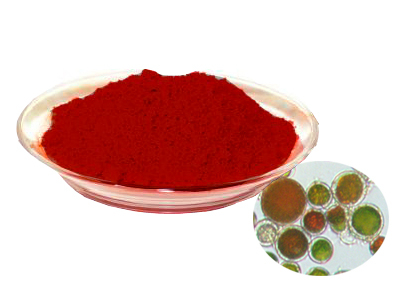Products
Haematococcus pluvialis Extract
Products name: Haematococcus pluvialis Extract 
Plant Source: Haematococcus pluvialis
Active Ingredient: Astaxanthin
Structural Formula
CAS Number: 70831-56-0
Molecular formula: C40H52O4
Molecular weight: 596.84
Astaxanthin is a powerful antioxidant that occurs naturally in various types of marine life, including krill, shrimp and salmon. Categorized as a carotenoid in the terpenes class of phytochemicals, the naturally occurring nutrient is considerably more powerful than antioxidants such as Vitamin E. This particular carotenoid can also be synthetically produced.
There are a number of sources for astaxanthin. Along with various types of fish, this nutritional supplement can also be harvested from yeast and even the feathers of a few birds. Along with ingesting the antioxidant by consuming fish, it is also possible to purchase the product in capsule and pill form for use as a daily nutritional supplement or as an additive to other foods.
It is not unusual for synthetic and natural astaxanthin to be used as an ingredient in feeds produced for chickens, shrimp, and salmon. The nutrient helps to add color to the meat and eggs as well as promote growth. This makes the inclusion of astaxanthin ideal for use on farms where shrimp, chicken, and salmon are actively cultivated for sale.
For humans, astaxanthin is valuable as an antioxidant. This property makes the nutrient ideal for boosting the function of the immune system. As a result, it can have a beneficial impact on preventing the development of heart disease. Because astaxanthin does cross the blood-brain barrier, it can also benefit the function of the brain, eyes, and the nervous system.
Fuctions
1. Astaxanthin and Joint Health
Astaxanthin has natural anti-inflammatory properties, but unlike prescription analgesics, it comes with no risk of addiction, heartburn, or gastrointestinal ulcers. Specifically, natural forms of astaxanthin block inflammatory COX2 enzymes, while at the same time suppressing serum levels of nitric oxide, interleukin 1B, prostaglandin E2, C Reactive Protein (CRP), and TNF-alpha (tumor necrosis factor alpha).
2. Astaxanthin and Skin Health
One of the reasons why salmon roe is red in color has to do with the high levels of astaxanthin that it contains. Astaxanthin has powerful UV-blocking properties that help protect the fish eggs from sun-related damage. Taking astaxanthin can also provide humans with similar health benefits. As a side benefit, the antioxidant has also been shown to reduce wrinkles, and to improve skin moisture levels.
3. Astaxanthin and Fatigue
Sockeye salmon has some of the highest levels of astaxanthin found in nature, with the exception of the purest form of the pigment. In fact, this is the reason behind the vibrant red flesh of the fish. Astaxanthin is also considered the primary reason why salmon have the energy it takes to make their arduous upstream voyages each year. Natural forms of this antioxidant also provide humans with increased strength, while also offering increased recovery from exercise.
4. Additional Health Benefits of Astaxanthin
One of the easiest ways to take advantage of the remarkable health benefits of astaxanthin is to take BioAstin from Nutrex Hawaii. Not only does this super-antioxidant benefit one's joints and tendons, eyes , skin, and energy levels, but astaxanthin also:
• Supports immune function
• Supports cardiovascular health
• Protects cells and the nervous system from oxidative damage
• Supports brain health
Specification:
1% - 10% Astaxanthin
- Prev: Pomegranate Seed Extract
- Next: Coriolus versicolor Extract
